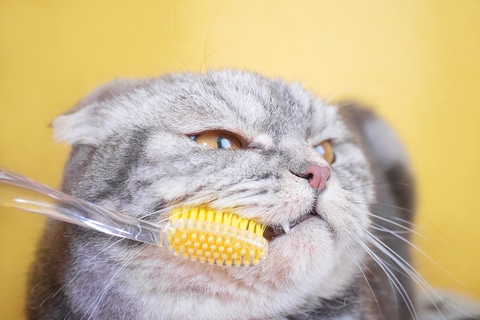

Cat Dental Care – All You Need To Know
A lack of focus on your cat’s dental care can lead to some serious problems and diseases down the road. Here is all the information you need to know about cat dental care.
Your cat’s dental health and hygiene is essential for its happiness and life. Cat dental care will not only ensure that your cat stays away from gingivitis and other dental diseases, but will also help them maintain fresh breath.
6.1 The vet’s philosophy
6.2 ISFM Practice Membership
6.3 If the clinic been declared cat-friendly by the ISFM
6.4 A separate waiting room
6.5 Staff attitude
6.6 Cat information
6.7 Usage of feline pheromones
6.8 The way your cat is taken out of the basket
6.9 Handling of cats
6.10 Cat comfort
6.11 Hygiene
1. Common Dental Issues among Cats
1.1 Formation of Plaque
Plaque is a film of food debris and bacteria that keeps building up and attaches itself to your cat’s teeth. Brushing, with its mechanical forces, is capable of removing plaque.
1.2 Tartar buildup
If plaque is not eliminated from the surface of the cat’s teeth, the saliva minerals will harden it and transform it into tartar – dental calculus which firmly adheres to the teeth.
1.3 Gingivitis
Once tartar attacks the tissues present in the gums, they redden due to the irritation and inflammation, ultimately leading to gingivitis. Once this condition occurs, the plaque bacteria constantly makes its way below your cat’s gum-line and causes gum infections of various kinds and degrees.
1.4 Periodontitis
The plaque bacteria present in the gum-line produces toxic substances which further damage the tissue. In addition to causing tissue damage and inflammation, bacterial infections will often trigger your cat’s immune system. Once the immune system is activated, it will start producing white blood cells and other anti-inflammatory chemicals to kill the bacteria. Unfortunately, this process causes many of the bony and soft tissues of the teeth to become damaged in a condition called periodontitis.
1.5 Root abscess
When cats have active periodontitis and gingivitis, their teeth can be infected by bacteria. The root will slowly be destroyed and deprived of blood supply. This causes the tissue to die out and, once again, brings the immune system into action and introduces an army of white blood cells. However, despite the immune system’s valiant efforts, the body fails to get rid of osteomyelitis (a kind of infection of the deep bone), and the cat requires surgical intervention performed by a veterinarian. The premolar teeth are the most vulnerable to abscesses and should therefore be prioritized during cat dental care.
1.6 Tooth loss
In the later stages of periodontal disease, the teeth attachments are lost and, as a result, the detached teeth will loosen and either come out or demand removal since these teeth cause pain and difficulty in eating.
2. The Importance of Cat Dental Care
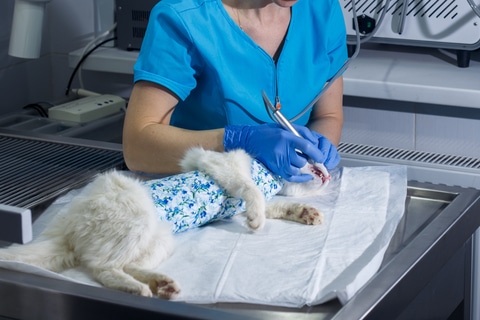
Wild cats usually chew on grass or bones to keep their teeth clean. Domestic cats, on the other hand, do not have a substitute for this method. Furthermore, animals are unable to let us know if they are feeling sick or are in pain. What this means is that it is crucial for pet owners to make sure that their pets have preventative and not reactive routines for cat dental care – this is especially true for oral health.
Additionally, you need to regularly examine your cat’s gums and teeth and make sure that they seem healthy.
Eight out of every ten cats aged three or above will suffer from gum and teeth problems. This is because when cats consume foods using the outer part of their teeth, they tend to develop plaque, debris, and bacteria. This germ coat continues to harden and, over time, turns into tartar, which then leads to gum irritation and can lead to gingivitis and even loss of teeth. In some cases, the immense extremity of the tartar scales means that they are not even reversible and require teeth removal.
If your cat is dealing with oral inflammation or pain, eating and drinking can become a severely difficult task. Moreover, there is the possibility of the bacteria making its way into your cat’s bloodstream and damaging vital organs such as kidneys.
The progressive destruction of teeth, gums, and the structures keeping the teeth together, is known as ‘periodontal disease’ – the most common one affecting adult dogs and cats. Thankfully, periodontal disease is very much preventable. To ensure that your cat is orally (and generally) healthy, you need to do a few things involving regular home assessments and veterinary visits.
3. Performing Cat Dental Care
Even though your cat will not particularly appreciate this experience, a regular oral assessment is crucial for its health. If your cat gets overly distressed or you are unable to examine its mouth, you should take them to an experienced veterinarian for a checkup.
Alongside appearing white and clean, your cat’s teeth should not have any chipping. The gums should be free of lesions and sores, and should have a pink color to them without any bleeding, swelling, or redness.
As part of your cat dental care routine, also examine the back of your pet’s mouth and make sure that there are no foreign bumps, lesions, or ulcers. The inside of the mouth, meanwhile, should not have any foreign objects (strings, for instance). If you find anything unusual, do not waste time and get it checked as soon as possible.
A cat’s breath should not contain any foul odors. This kind of smell could indicate an infection – not just in the mouth, but anywhere in the body – and should be checked by a veterinarian. A persistently bad breath suggests serious periodontal disease which will have to be assessed and treated.
There are several other signs of dental disease, which include face pawing, difficulty swallowing, drooling, or any changes to your cat’s weight or eating patterns.
4. Maintaining Cat Dental Care and Health
Brushing your cat’s teeth twice a week – if not daily – will help keep its gums and teeth healthy. It is normal for adult cats to resist teeth cleaning, which is why you need to get them accustomed to this practice from the time that they are kittens. For this purpose, you can use finger cots, or gauzes covered with toothpaste developed particularly for cats. This will help your kitten get used to the experience; you can also take water from a tuna can and cover your finger with it to increase the pleasantness of this experience for your pet.
For regular cleaning routines, make sure that you possess the required equipment. Almost all pet stores and veterinary clinics have dental kits that you can purchase. Remember that under NO circumstances should you use human toothpaste to clean your cat’s teeth – the high fluoride content in human toothpaste, if ingested by your cat, can make it extremely ill. Also, since you have little control over the amount of toothpaste your cat will swallow, it is best to completely avoid using human toothpaste. Toothpaste made specifically for cats are free of fluoride, and is often available in chicken or beef flavors.
For brushing, you can make use of either a finger/rubber toothbrush or a sterile gauze strip. Cradling from behind will make your cat feel supported and comforted, so make sure that you do that. Next, tilt the head back gently and lift the chin up to open the mouth, as this will make it easier for you to access your cat’s teeth. Avoid using dental flosses because, if swallowed, they can damage your cat’s intestines.
5. Taking Care of Your Cat’s Oral Care
Dental care is not just restricted to the teeth. Remember that the root cause behind decaying teeth is usually inflamed or irritated gums and therefore, the gums need to be equally healthy. Once you are done with the teeth brushing, you should gently massage your cat’s gums in order to promote strengthening and healing. Moreover, the increased blood flow will lower the possibility of gum issues down the road.
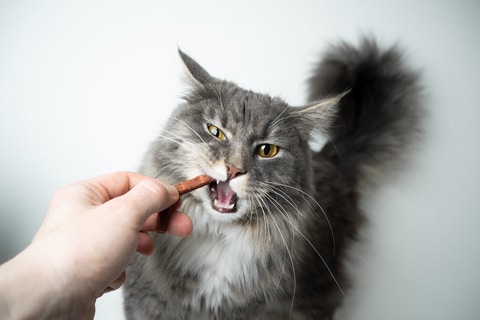
There are several products that you can use to improve your cat’s mouth health. Several formulated treats are designed to reduce plaque and tartar buildup and improve a cat’s breath. Your veterinarian can recommend these products, and they will often contain ingredients that are also beneficial for your cat’s general health. These ingredients include taurine, selenium, vitamin E, and antiseptics useful for getting rid of any bacteria in the cat’s mouth.
Your veterinarian should also have dental sprays that you can purchase. Spraying these into your cat’s mouth once or twice a day should help keep their tartar and plaque levels in check. Also ask your vet about any dental diet that you can implement. You can also use water additives, but make sure that the unfamiliar flavor will not reduce your cat’ desire to consume water.
There are several easy and effective options available for your cat’s oral health. However, if you find that your cat is extremely resistant despite all your efforts, your best option would be to take them for professional cleaning at least once a year. In fact, since periodontal disease can even develop with healthy and white teeth, regular dental cleanings can help prevent it. For this reason, we strongly recommend these dental cleaning sessions.
The vet will use general anesthesia for the cleaning; this will enable them to remove hard, calcified plaque and plaque, polish your cat’s teeth, and perform a complete oral examination, including inspecting the gums.
Furthermore, the vet will also be able to eliminate any bacteria from under the cat’s gums, and even perform any procedures such as X-rays in order to detect any dental disease. It is important to note that the older the cat, the more frequent it should have its teeth cleaned.
6. Choosing a Veterinarian for Your Cat Dental Care –Things to Consider
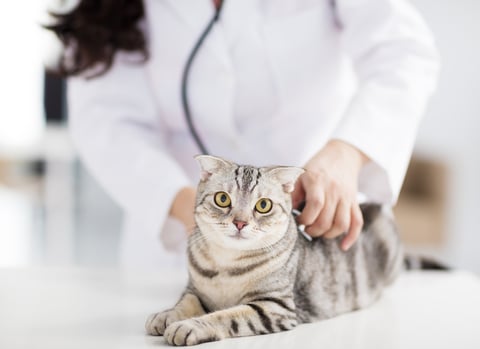
6.1 The vet’s philosophy
Your cat is a part of your family dynamic and your bond with your pet is extremely important. For this reason, you need to make sure that your cat will get a satisfactory veterinary experience customized to suit its requirements.
6.2 ISFM Practice Membership
The ISFM (International Society of Feline Medicine) handles the veterinary aspect of International Cat Care. This division provides Practice Membership to veterinary clinics – members get a certificate that can then be displayed and help clients know that they will benefit from the latest developments and premium information regarding cat care.
6.3 If the clinic been declared cat-friendly by the ISFM
The ISFM has initiated a program related to cat-friendliness, according to which clinics are required to have the kind of attitude and facilities that will alleviate a cat’s stress related to a veterinary visit. A cat-friendly clinic accredited by the ISFM will adhere to certain standards which will help ensure that the veterinary visit is pleasant for both your cat and yourself.
6.4 A separate waiting room
A lot of clinics provide segregated waiting areas for cats – away from the sound, sight, and stress of dogs. Since such a waiting area is highly beneficial for your cat, you should check if any vet clinics in your area offer this facility. These rooms also contain chairs, benches, and shelves that you can use to elevate the cat basket and make your feline friend feel less vulnerable and more secure.
Also, a reduction in visual contact, even if done through a blanket or clean towel placed over the basket, also plays a role in keeping cats calm. Instead of a separate waiting region, some clinics have consultation times dedicated to cats, so that cats do not have to wait in a room that contains dogs.
6.5 Staff attitude
It is a common assumption that the entire clinic staff, ranging from the veterinarian to the receptionist, will be aware of the crucial differences in dealing with dogs and cats. Unfortunately, that assumption is often misguided. However, the clinic greets you and your cat, the kind of questions that the staff asks you, and the suggestions you receive during your first visit should tell you a lot about the clinic and the attitude and knowledge of the clinic people working there.
6.6 Cat information
You should also see if the clinic provides valuable information regarding cats – for instance, leaflets about transporting your cat or administering medications.
6.7 Usage of feline pheromones
Many clinics use pheromones that are friendly for cats. These pheromones are almost identical to those produced by cats themselves when they are looking to communicate or connect with other cats. These pheromones help cats calm down and feel more at home. You might not be able to smell the pheromones, but some clinics make use of diffusers or sprays in the consultation and waiting rooms.
6.8 The way your cat is taken out of the basket
Naturally, the vet will examine the cat, but the approach to this examination is also crucial. A skilled vet with a good understanding of cats will know that the cat will normally open the basket lid or door, and while conversing with you, you will want to see whether your cat emerges from its basket all by itself.
Moreover, such a vet might be able to perform certain examinations without even taking the cat out of the basket (particularly if the top or lid comes off). There will be times when a cat will not pop out of the basket voluntarily; in which case, the vet will have to bring it out. Make sure that the vet goes about this in a respectful and gentle manner. You might want to have some extra bedding with the cat basket so that the bedding and the cat can be brought out together.
6.9 Handling of cats
Capable nurses and vets go the ‘less is more’ route. It is natural for cats to want to stay clear of danger, and, if they realize that they have been held very firmly and are unable to escape, they might end up panicking.
Cat examination is all about doing the minimum yet achieving the maximum results; this is done by avoiding restraint and being gentle and confident. Moreover, if any procedures or examinations might upset or unsettle the cat, those should be left for the last. Also, if the nurse and vet avoid eye contact with the cats and perform the bulk of the examination with the cat facing in the opposite direction, they can further help in reducing your cat’s anxiety.
Vets should also take breaks between examinations and allow the cat to identify a spot where it feels calm and relaxed (this could even be the floor or the windowsill). Placing a rubber mat or the cat’s blanket or bedding on the table will help ensure that the cat does not have to stand on a slippery surface.
6.10 Cat comfort
Several elements that make a cat-friendly clinic will be present behind the curtains – such as having a cat-only hospitalization ward or comfortable cages (that have cozy bedding and hiding places). These simple things create a significant difference and therefore, you should never be hesitant to enquire about your cat’s staying area should it require a clinic stay.
6.11 Hygiene
Naturally, hygiene is extremely important, and the consulting rooms and waiting areas should be well-maintained and clean. The staff should be well-trained, courteous, and wearing clean uniforms and using clean equipment. Also, the clinic should not contain any odors and must be sufficiently ventilated.
7. Things to Ask Your Veterinarian about Your Cat’s Dental Health
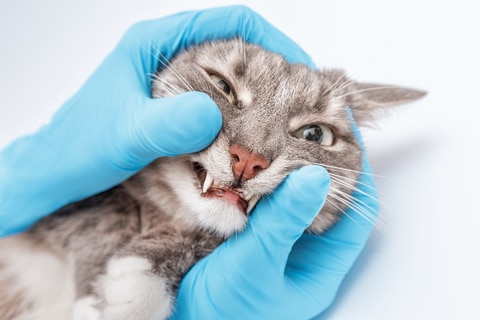
7.1 The recommended diet (if any)
As we mentioned previously, certain dental diets can benefit your cat’s oral health. Ask your veterinarian if your cat needs to be on such a diet. If so, discuss the contents of that diet and make sure that they will cover the nutritional requirements for your cat.
7.2 Diseases to watch out for
Certain cat breeds are predisposed to certain dental diseases. If you are aware of what you need to look for, you will be able to detect, diagnose, and treat it sooner and spare yourself and your cat a great deal of pain, suffering, and stress.
7.3 Recommended blood tests or examinations
Dental and oral diseases can be detected early by performing various tests and exams. Moreover, since pets cannot explicitly tell you where they are hurting or what is wrong with them, such assessments become all the more important.
Make sure you understand all of the tests required to detect and rule out feline diseases, not just oral diseases.
7.4 How to brush your cat’s teeth and the recommended frequency of professional cleaning
As stressed at multiple points in this post, daily brushing and cleaning are essential for preventing tartar accumulation and periodontal disease. Start with twice or thrice a day and, if your cat is cooperative, go for daily brushing.
Also, oral and dental examinations should be part of every veterinarian visit. If your cat has any oral or dental issues, it might hurt them to get their teeth brushed. During the exam, the vet will make recommendations regarding professional cleaning. These recommendations will be based on your exam results and how well you are following your home cleaning regimen.
8. Final Word on Cat Dental Care
Dental and oral health are vital aspects of your cat’s overall health, happiness, and prosperity. We hope that this comprehensive guide on cat dental care will provide you with all the information that you need on the topic and help you make sure that you cover all the aspects of your cat’s dental health and hygiene.
Discover how to create a joyful, healthy home for your pet.
Subscribe to your weekly rundown of practice, real life ideas and training tips straight to your inbox.


